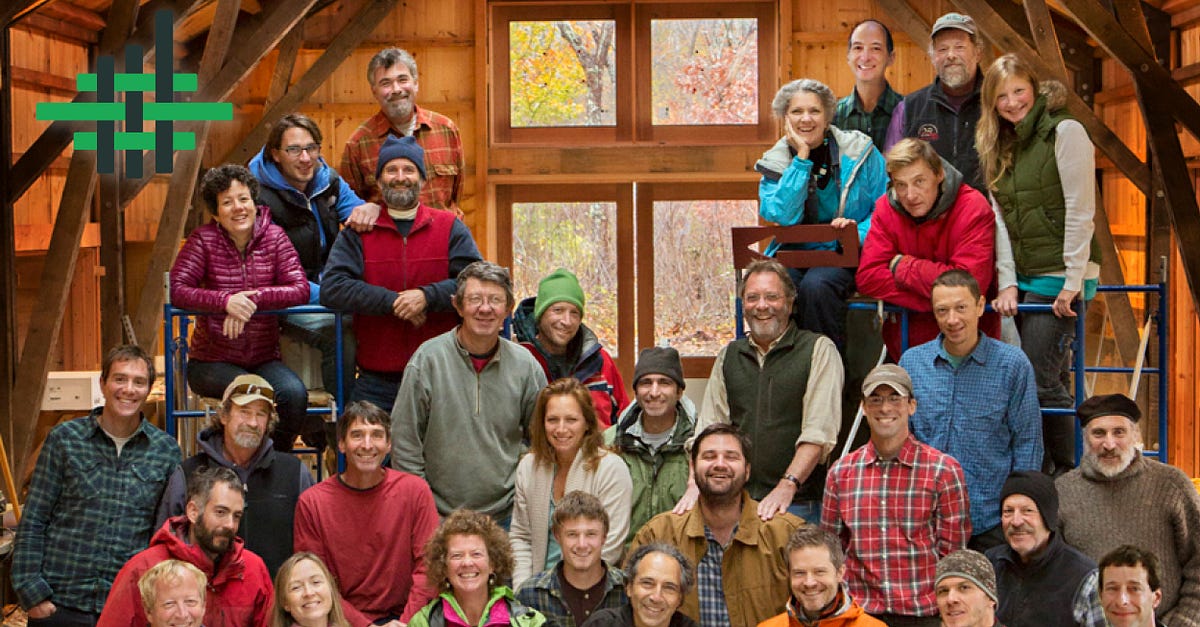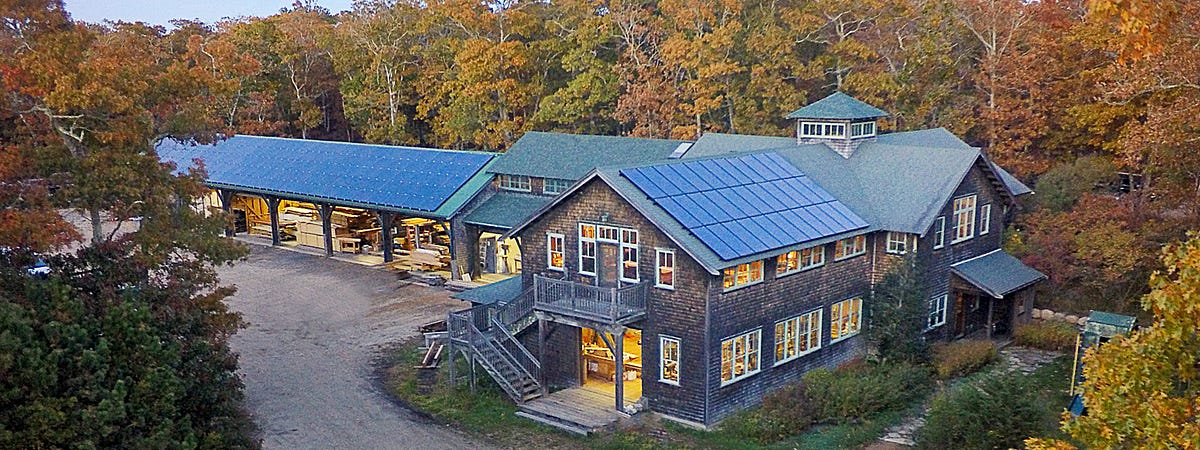A Mission-Led Employee-Owned Firm
By Sarah Stranahan

The best of the best is what you might say about South Mountain Company, an employee-owned, environmentally oriented design-build firm on Martha’s Vineyard, off the coast of Massachusetts. It’s a B Corp, a new type of company that uses the power of business to solve social and environmental problems. Every year, B Lab, which certifies B Corporations, lists those that are “Best for the World.” In 2017, South Mountain not only made that list, it was one of only two companies that were rated best for employees and best for the environment.
South Mountain, with roughly $10 million in revenue and 35 employees, works toward ecological sustainability in everything it does. It creates what it calls “22nd century” buildings that are low impact. A fundamental goal for each building or deep energy retrofit is that the building be net zero, producing more energy than it consumes. The firm performs life cycle analysis on materials, and for 30 years has used reclaimed wood, salvaged from lake and river bottoms, wine and beer tanks, and dismantled buildings. South Mountain aims to create a workplace that engenders the spirit of craft — and finds employee ownership contributes to this spirit.
One hypothesis being researched by The Democracy Collaborative is that hybrid firms like South Mountain — mission driven and employee owned — naturally make better environmental stewards. To further our research in this area, we are talking to entrepreneurs such as South Mountain co-founder and CEO John Abrams to understand how they think about these issues within the context of their business.
Abrams has been a successful entrepreneur since the 1970s. Ten years after he started South Mountain, he restructured the company as a worker cooperative, and in December 2012, he and his co-owners converted the business to a B corp. Additionally, in 2005 South Mountain started a solar installation company that has installed 272 solar systems offsetting 5107 barrels of oil and 4,851,098 lbs. of CO2.
When we called Abrams, we wanted to learn how South Mountain has prospered while sticking to its principles: shared ownership, workplace democracy, commitment to long-term thinking, limited growth, environmental sustainability and a deep commitment to place.
We asked John, “Where did South Mountain’s principles come from?” and he answered our question by telling a story.
John Abrams: Before I started South Mountain, my wife Chris and I spent six years on a back-to-the-land “hippie odyssey.” Recently I have been thinking about how that time shaped our lives. I think those experiences were the source of the environmental care and the cooperative spirit, which were combined from the start. It was part of who we were at South Mountain from the very beginning, and it’s stayed that way. The worker co-op and the B Corp only formalized the values that were already there.
TDC: Do you worry about how South Mountain can maintain those moral values beyond your tenure as the founder? What would happen to South Mountains’ commitment to the environment and its employees if it were sold a larger publicly traded company?
Abrams: That’s unthinkable. The idea is so antithetical to everyone here, it would never even get on the table. Plus, in our governance structure, there are two things that cannot be done except by full consensus of the 20-plus owners:
- Selling the company, or
- Using our Equity Fund (an internal fund of built-up employee wealth) for any purpose other than paying out departing/retiring owners.

TDC: So you believe that employee ownership is the best insurance for protecting the mission and values of South Mountain?
Abrams: It’s the best guarantee of our mission. When we restructured South Mountain as an employee-owned cooperative, that ownership stake changed people’s views, their commitment, their level of responsibility. The people who are making business decisions bear the consequences (and the rewards) of those decisions — and they truly have the power to set the course of the business. That causes a tremendous level of engagement.
TDC: The worker co-op structure protects employee ownership and democratic principles, but does it also protect the environmental commitment?
Abrams: I don’t think the worker co-op structure protects our commitment to the environment per se. But the B Corp certification process does. The biennial B Corp audit makes us constantly aware of our environmental impact; it includes detailed questions about energy, water, waste, and supply chains.
We care as deeply about protecting the long-term mission of the firm and the core values that define it, as we care about anything.
TDC: Is there ever a tradeoff between your commitment to employee well-being and your commitment to ecological sustainability?
Abrams: There is always competition for limited resources and how to allocate them. We have made decisions NOT to do business if we think a project will have a negative effect on the environment or our community. For example, over the years we watched our island change. Wealthy summer people were tearing down our traditional small historic New England cottages and building huge mansions that sit empty, burning fuel all winter. We grew increasingly uncomfortable about the environmental impact of those giant heat-guzzlers and decided not to build homes bigger than 3,500 square feet, unless there was a very good reason. At the same time, we dedicated ourselves to increasing the availability of affordable housing for working people.
These efforts at stewardship have contributed to important changes: Chilmark passed a big house bylaw, the Martha’s Vineyard Commission did a long-term Island Plan, and all the towns have been part of the affordable housing efforts.
It’s hard to imagine that future employee owners wouldn’t care about the environmental impact on our community because people who work here, live here, raise their families here, and are deeply connected to the island.
TDC: It’s great to stay local and forgo the need for constant growth and expansion, but how do you stay competitive with big companies that have economies of scale?
Abrams: Our solar company is a member of the Amicus Solar Co-op, a national group of 50 progressive solar companies that formed a purchasing co-op. It helps us compete with larger solar companies, and it is a remarkable forum for sharing best practices. Amicus has also formed a credit union to help our customers finance their solar installations. Of Amicus members, 40 percent are B Corps, and more are in the process of becoming B Corps. At least six are now worker co-ops, and three or four are ESOPS. Everyone is thinking about legacy planning, triple bottom line practices, and workplace democracy.
One of Abrams’ favorite quotes is from Charles Handy’s The Hungry Spirit: “We may not need any more cathedrals, but we do need cathedral thinkers, people who can think beyond their own lifetimes.” Abrams’ cathedral thinking is evident in his legacy: South Mountain recently celebrated its 46th anniversary. For nearly half a century, the people at South Mountain have been creating good jobs and environmentally sustainable housing for the Martha’s Vineyard community. As an employee-owned business with deep roots in the community, they expect that the company will continue to prosper long after its founder is gone.
Sarah Stranahan is Senior Editorial Associate at The Democracy Collaborative, and a leading member of its Fifty by Fifty employee ownership team.
Fifty by Fifty is working to transform the U.S. economy by growing employee ownership. Join our campaign, and we’ll send our monthly newsletter, filled with great company stories, right to your in box.
